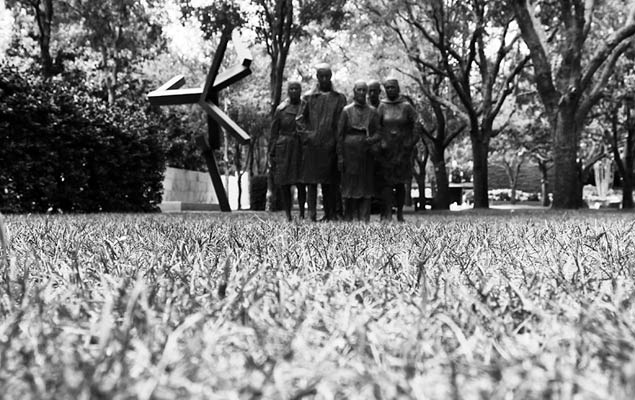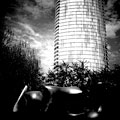
Nasher Sculpture Garden
Dallas, TX
We did a lot of research and found that there is no inner-city sculpture museum and garden in the world. Sculpture gardens are usually out in parks, like in Purchase, NY. The most important one is in Holland, the Kroller-Muller Museum outside of Amsterdam. My thought was if we could take the collection and get a great building and garden together within the inner city, perhaps it could be a local center of modern sculpture in the world – and that would be important for the future of Dallas. — Raymond Nasher, Interview with Diana Mehl, Panacheprivee.com
History
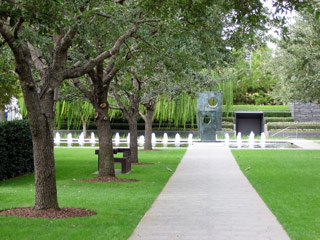
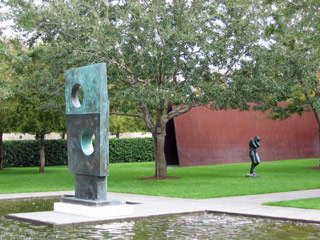
Photos courtesy The Cultural Landscape Foundation.
The Nasher Sculpture Garden, designed by landscape architect Peter Walker, is part of the Nasher Sculpture Center, which covers a full city block in downtown Dallas, Texas. The 10,000 square foot museum and 1.5-acre sculpture garden were completed in 2003 to house the extensive modern and contemporary art collection of real estate developer and banker Raymond Nasher and his wife Patsy.
The Nasher’s first began collecting art in the 1950s. The couple’s early collection focused on their interest in Pre-Columbian and modernist art. By the end of the 1960s the collection contained significant sculptures by modern masters including Alexander Calder and Isamu Noguchi. As their collection grew, the Nashers, who were passionate patrons of the arts, also began collecting the work of contemporary artists.
As early as the mid-1960s, Raymond Nasher was displaying works from the collection publicly, often putting them on view in his Dallas area real estate developments – most notably his NorthPark shopping Center – and by the mid 1970s sculptures from the Nasher collection were exhibited in museum and gallery exhibitions worldwide. Raymond Nasher continued to collect art after his wife’s death in 1988, and by the time of his own passing in 2007, the collection contained more than 300 significant works of art.
The Nasher’s hoped to one day have a permanent venue to house their sculpture collection, and in 1997, Raymond Nasher announced his plans to fund such a complex. Raymond Nasher envisioned a museum that would provide for a seamless transition between indoor and outdoor space, thus integrating architecture and art with nature to provide a quiet oasis for the contemplation and study of art within the busy core of the Dallas city center. He commissioned architect Renzo Piano to design the modern low-rise Italian travertine building, and landscape architect Peter Walker to design the outdoor sculpture garden. Ground broke on the project in 2001. At its completion in 2003, the complex, which cost $72 million dollars to construct, contained five pavilions housing galleries, offices, a gift shop and café, and a 1.5-acre outdoor sculpture garden.

Photo © Angela Bacon-Kidwell
The museum and garden were designed to take advantage of natural air and light. The museum’s pavilions are topped by a barrel vaulted glass ceiling that allows natural light to filter down and illuminate the museum’s collections; to temper and control the flow of the sun’s rays Piano developed a cast-aluminum sunscreen for the building, which was delicately calibrated to allow light to filter in from the north, in order to protect the sculptures and visitors from over-exposure to heat and light. The pavilions themselves were also laid-out in order to account for the sun’s path across the sky. The outdoor sculpture garden consists of a linear plane of lawn and terraces. Plantings help divide the space into garden rooms, and include more than one-hundred trees of varying species set into the landscape in clusters and as allées – linear avenues of trees that provide formal structure to the design. Dappled sunlight spills through the branches of the trees, which include weeping willows, live oaks, crepe myrtles, magnolias and cedar elms, which along with three water features, creates an idyllic experience for visitors. The gently sloping garden serves as a large open-air gallery; at its center, a verdant lawn features a collection of permanent and rotating sculpture exhibitions that generally number around thirty at any given time. Since its completion in 2003 the Nasher Museum and Sculpture Garden has been a central feature of Dallas’ revitalized Arts’ District.
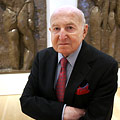
Patron
Raymond and
Patsy Nasher
Threat
In 2012 construction was completed of a high-rise condominium overlooking the Nasher Museum and Sculpture Garden site. The building, currently owned by the Dallas Police and Fire Pension System, was designed by Los Angeles architect Scott Johnson, and named “Museum Tower” in homage to its neighbor. The 42-story building – which was originally slated to be half its current size and is now one of the tallest residential buildings in the city - is sheathed in a reflective glass skin that acts like a mirror and reflects damaging and intense rays of sun into the Sculpture Center and Garden.
Museum officials first noticed problems with the glare from the tower during its construction in September of 2011 at which time they brought the issue to the attention of the condominium’s developers, but construction of the building continued. Presently, during peak daylight hours, the sunlight reflects into the museum and garden increasing the temperature inside the museum to uncomfortable levels. The increased light levels also disrupt the museum’s carefully controlled environment threatening the collection’s safety, in addition to casting distracting shadows from the roofs perforated screen onto the walls and art. In the sculpture garden, the tower’s glare creates a blinding experience for visitors, and has affected the plantings, burning leaves and grass. The light has also detrimentally affected the artwork leading to the removal of several pieces including James Turrell’s site-specific work Tending, (Blue) and Pablo Picasso’s Nude Man and Woman.
Museum officials are currently in negotiations with the condominium’s developers to ameliorate the situation, but have yet to reach a feasible solution that would prevent further damage to the galleries and garden, or call for significant alterations to the sculpture center’s design.
How You Can Help
To learn more about the current controversy surrounding Museum Tower and the Nasher Museum and Sculpture Garden, and support efforts to reach a solution, please visit the museum Web site.
Learn More
Nasher Sculpture Center
2001 Flora Street
Dallas, TX 75201

